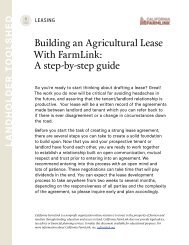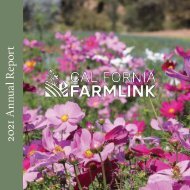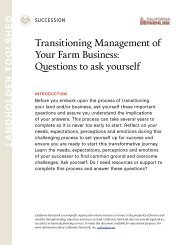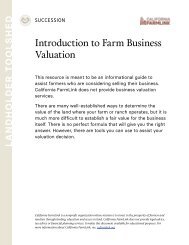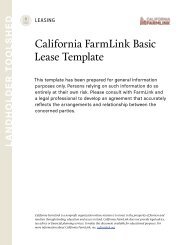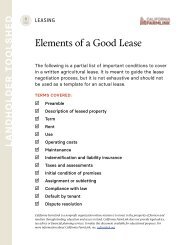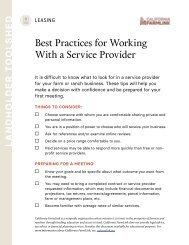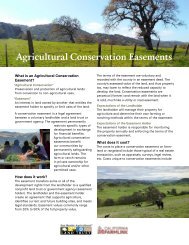Understanding Lease Payment Structures
You also want an ePaper? Increase the reach of your titles
YUMPU automatically turns print PDFs into web optimized ePapers that Google loves.
LANDHOLDER TOOLSHED<br />
LEASING<br />
<strong>Understanding</strong> <strong>Lease</strong> <strong>Payment</strong><br />
<strong>Structures</strong><br />
This resource is designed as an informational reference to convey a<br />
basic understanding of lease payment structures and options. For more<br />
information about lease agreement structures see our publication,<br />
“Growing on Solid Ground: A Farmer’s Guide to Land Tenure”. The evaluation<br />
considerations outlined in Evaluating and Preparing Property for Leasing<br />
to an Agricultural Tenant can assist you in determining how to price a<br />
property lease.<br />
It is important to understand appropriate options and ranges but ultimately<br />
the product(s) of the farmer or rancher will influence the outcome, so be<br />
prepared to work with a prospective tenant to determine an appropriate<br />
rate. Therefore, you may need to find a tenant prior to being able to<br />
determine the rate accurately. Also remember that a responsible,<br />
dependable tenant may be worth incentivising.<br />
You can often find a range for conventional lease rates for your county<br />
in the annual publication from the California Chapter of the American<br />
Society of Farm Managers and Rural Appraisers, “Trends in Agricultural<br />
Land and <strong>Lease</strong> Values” or through the National Agricultural Statistics<br />
Service. Keep in mind, these rates will also depend greatly on the type of<br />
agricultural production implemented on the leased land and size of the<br />
parcel. California FarmLink is happy to help assist you in thinking through<br />
the process of determining your lease rate and structure, and we can<br />
sometimes provide a range of market rate lease rates, but ultimately there<br />
is no “right” amount you should charge, that will be up to you and the<br />
tenant to agree upon.<br />
California FarmLink is a nonprofit organization whose mission is to invest in the prosperity of farmers and<br />
ranchers through lending, education and access to land. California FarmLink does not provide legal advice,<br />
tax advice or financial planning services. It makes this document available for educational purposes. For<br />
more information about California FarmLink, see: cafarmlink.org
LANDHOLDER TOOLSHED<br />
<strong>Understanding</strong> <strong>Lease</strong> <strong>Payment</strong> <strong>Structures</strong><br />
CASH RATE<br />
Cash leases are calculated at a peracre,<br />
per-year basis. <strong>Payment</strong>s can<br />
be made monthly, quarterly, semiannually<br />
or annually. This structure is<br />
the most straightforward and offers<br />
autonomy and consistency for the<br />
landholder and tenant.<br />
PROGRESSIVE RATE<br />
Progressive cash lease rates<br />
incorporate a schedule for defined<br />
rent increases over time. This<br />
can afford a new operation the<br />
opportunity to ease into larger<br />
payments as they grow their<br />
business.<br />
CROP SHARE<br />
A crop-share lease structure is most<br />
commonly used with permanent,<br />
perennial or commodity crops. Share<br />
rents are calculated as a percentage<br />
of the net or gross proceeds from<br />
sale of crops or products grown/<br />
produced on the property. Share<br />
rents can also include a minimum<br />
or additional cash rate, increases<br />
based on market or sale prices, or any<br />
combination of options. <strong>Payment</strong>s<br />
can be made monthly, quarterly,<br />
annually or after every sale. A cropshare<br />
lease often includes an auditing<br />
of records allowable up to and for<br />
a period after a lease terminates.<br />
The tenant must be willing to keep<br />
open books with their landlord.<br />
Crop share leases must be built on<br />
trust and excellent record keeping.<br />
There is a history of racism and<br />
exploitation associated with cropshare<br />
lease structures that should<br />
be acknowledged and respected<br />
during negotiations. Modern share<br />
lease agreements can be fair and<br />
beneficial to both parties if proceed<br />
percentages are within current<br />
market standards.<br />
GROUND LEASE<br />
Ground leases are used most<br />
commonly with commercial real<br />
estate. They are used in agriculture<br />
when the tenant constructs and/<br />
or owns significant permanent<br />
infrastructure and/or buildings on the<br />
property, and can be structured as<br />
a cash or crop-share arrangement.<br />
Most permanent lease models often<br />
incorporate a pathway to ownership<br />
such as right of refusal or option to<br />
purchase.
LANDHOLDER TOOLSHED<br />
<strong>Understanding</strong> <strong>Lease</strong> <strong>Payment</strong> <strong>Structures</strong><br />
ANIMAL UNIT MONTH (AUM)<br />
This is a standard measure for<br />
defining the cost of grazing land.<br />
“One AUM” is typically in reference to<br />
a steer or cow/calf pair on pasture for<br />
one month. Different animals (bulls,<br />
sheep, horses) may also be billed in<br />
reference to an AUM, for example a<br />
bull may be billed as 1.4 AUM, and a<br />
llama at 0.2 AUM. AUM can be used<br />
to define minimum and maximum<br />
stocking rates. <strong>Payment</strong>s can be<br />
made weekly, monthly, quarterly,<br />
semi-annually or annually. For more<br />
information on AUM rates and other<br />
grazing specific fee structures, please<br />
refer to the grazing handbook (pg<br />
33) from the Sotoyome Resource<br />
Conservation District.<br />
leases are significantly higher than<br />
agricultural leases and a landholder<br />
should research comparables prior<br />
to setting a price. Greenhouses and<br />
barns are usually calculated at a persquare-foot<br />
per month rate, but can<br />
be paid along with the determined<br />
cash payment for the acreage. The<br />
price will depend on the available<br />
amenities and condition of the<br />
infrastructure.<br />
EQUIPMENT<br />
Equipment can be incorporated into<br />
an agricultural lease or negotiated<br />
separately. Equipment can be<br />
provided as part of an agricultural<br />
lease, or charged for use hourly,<br />
monthly or yearly. It is important to<br />
specify maintenance and replacement<br />
responsibilities.<br />
BUILDINGS (GREENHOUSES,<br />
HOUSING, BARNS, ETC.)<br />
Residences can be incorporated<br />
into agricultural leases or addressed<br />
in a separate agreement. It is not<br />
recommended to include residences<br />
in an agricultural lease if the term<br />
length and payment schedule are<br />
significantly different. A landholder<br />
must take into account state<br />
renters and landlord regulations and<br />
expectations prior to entering into a<br />
residential lease. Prices for residential<br />
RENT REDUCTIONS AND<br />
INCENTIVES<br />
Rent credits, reductions or incentives<br />
can be built into any lease structure.<br />
Rent Reduction or Credit for Product<br />
or Work Exchange<br />
If offering a reduction in rent in<br />
exchange for work, maintenance<br />
projects completed or goods, one
LANDHOLDER TOOLSHED<br />
<strong>Understanding</strong> <strong>Lease</strong> <strong>Payment</strong> <strong>Structures</strong><br />
must first establish a lease rate<br />
and cost for hourly labor and/or<br />
product(s). The language of the lease<br />
will then provide the opportunity to<br />
pay down the lease rate with product<br />
and/or labor up to a maximum. It is<br />
essential to define acceptable work<br />
exchange activities and products for<br />
exchange. Be careful to outline that<br />
the maximum rent reduction shall<br />
not exceed the lease rate so that the<br />
agreement does not inadvertently<br />
become a labor contract subject<br />
to other laws and considerations.<br />
For significant and/or skilled labor<br />
activities, it is advised to hire the<br />
tenant or another skilled professional<br />
as an independent contractor outside<br />
of a lease agreement.<br />
Conservation Incentives<br />
Common incentives or credits can<br />
be issued for ecosystem services,<br />
regenerative goals or practices<br />
achieved and/or implemented, organic<br />
or environmental certifications,<br />
infrastructure investments, and/<br />
or irrigation systems that conserve<br />
water. Rent incentives should identify<br />
metrics for calculating credits,<br />
maximum caps on reductions, and<br />
establish a process for determining<br />
baselines, monitoring, adherence and<br />
verification.




